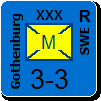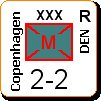Frederyck
Posts: 427
Joined: 12/7/2005
From: Uppsala, Sweden
Status: offline

|
quote:
ORIGINAL: paulderynck
quote:
ORIGINAL: Frederyck
This rule is one of those that is most often misunderstood, along with the very very strange ruling about how to get Partisans:
"13.1
You put a partisan unit in the country if the result [of the die roll] is less than or equal to that country’s (modified) partisan number. If it is at least 11 less (my bold face), place 2 partisan units in the country. If it is at least 21 less, place 3 partisan units in the country. If the roll exceeds the partisan number, there is no effect."
It is the "at least 11 or less" that causes problems. If a country's modified partisan value is:
1 -> 10% chance of 1 partisan.
2 -> 20% chance of 1 partisan.
...
9 -> 90% chance of 1 partisan.
10 -> 1 guaranteed partisan. No chance of a second partisan as "at least 11 less" than 10 is -1.
11 -> 1 guaranteed partisan. No chance of a second partisan as "at least 11 less" than 11 is 0 (zero).
12 -> 1 guaranteed partisan. 10% chance of a second partisan as "at least 11 less" than 12 is 1.
The logical progression would (to me) be that you would count "at least 10 less", giving a modified partisan number of 11 a 10% chance of getting 2 partisans and so on, but that is not how the rule is written. Although I do believe that many people play that way.
I agree that its written confusingly, but I don't get your interpretation of "at least 11 less". In reading RAW, I conclude the word "modified" in "modified partisan number" is only in reference to halving the partisan number for an unconquered country at war the same year. The addition for the garrison and subtraction for already existing partisans are applied to the partisan die roll - not the partisan number.
A recent example from our game in progress: USSR came up as subject to partisans. It is not the first year of war involving the USSR, so the (modified) Partisan Number is 30. One partisan was already there and the Axis garrison was 19. A '1' was rolled. Add 19, subtract 1 yields a die roll of 19. 19 is at least 11 less than 30 so the Russians got two more partisans. I don't see the problem with the difference of 11 and I think the table in your post is incorrect concerning 11s. (And 21s no doubt.)
I agree with your interpretation of "modified". But that doesn't invalidate my problem with the ruling. For arguments sake, let's say that there are no (zero) garrison units in a country that is eligible for partisans, and that there are no partisans present either. Also, let the country in question have been declared war on several years ago.
* If the partisan number for this country is 9 according to the map (Yugoslavia), you now have 90% chance of getting a partisan in that country (Ie, a roll equal or lower to the partisan number).
* If the partisan number was 10 according to the map (Italy), there would be 100% chance of getting a single partisan, and no chance of a second.
* If the partisan number was 11 according to the map (doesn't exist, I think, but that is beside the point), you would still have 100% chance of getting 1 partisan and NO chance of getting 2 partisans. To get 2 partisans in this case with no garrison units and no already present partisans you would need to roll "at least 11 less" than 11. And that is zero which cannot be rolled.
I think this is wrong. The wording ought to be "at least 10 less". That would mean that a partisan value of 11 (with no modifiers) would yield 1 partisan 90% of the time (roll=2-10) and 2 partisans 10% of the time (roll=1 which is at least 10 less than 11). If the wording is kept the chances of getting partisans is not linear, which I believe the designers meant it to be.
|
 Printable Version
Printable Version


















 New Messages
New Messages No New Messages
No New Messages Hot Topic w/ New Messages
Hot Topic w/ New Messages Hot Topic w/o New Messages
Hot Topic w/o New Messages Locked w/ New Messages
Locked w/ New Messages Locked w/o New Messages
Locked w/o New Messages Post New Thread
Post New Thread